
SEO competitive analysis is a critical task for site owners and marketers. Yet far too many are either not doing it, or are not doing it as a regular part of their schedules.
In this article, we’ll dig into the process of competitive analysis step by step using SEMrush, our favorite tool for this task.
 |
SEMrush |
||||||
The purpose of SEO competitive analysis
A thorough competitive analysis is used as part of your roadmap of what you need to do to improve your site to effectively compete in your niche or industry.
An SEO competitive analysis can also be used to identify what your site does well and weaknesses it has, alongside your competitors.
– What do your competitors do well that you could emulate?
– Where are your competitors weak where you could possibly capitalize on to improve site and search performance?
– What search terms are you competing well for and which ones could you realistically improve on?
– What terms have popular demand, but aren’t currently being covered adequately?
In this article we’ll cover the following:
- Why SEO Competitive Analysis is Important to Your Business
- Who are your Actual Competitors?
- “White Space”: Finding Keyword Gaps
- Finding Popular Pages
- Identifying Your and Your Competitors’ Strengths and Weaknesses
- Analyzing Page by Page
- Backlinks: What to Look For
- Types of Content and How to Analyze Them in SEO Competitive Analysis
- Identifying Search Features
- Featured Snippets & How to Analyze Them
- Doing SEO Competitive Analysis after Major Algorithm Updates
Why SEO Competitive Analysis is Important to Your Business
With competitive analysis, you are looking down from a macro view at the overall niche or industry.
You will want to know things like:
- where you are
- who your main competition is
- what important keywords you should be competing for
Whenever there are high-quality commercial keywords there will be competition.
Even if you are already ranking in a strong position for most of the important keywords in your niche, there will always be new competitors looking to take over your positions and capitalize on areas where your site could use competitive improvement.
Laying out a plan
Competitive analysis can be used a roadmap to determine what you need to do to improve your search rankings and the overall user experience for your site.
No site dominates a niche entirely. There are always competitors doing something a bit better to outrank others and/or provide a better user experience.
You might also find that they perform better in certain aspects of the search results, such featured snippets or in people also ask sections.
Even if you rank first for important keywords in your niche, if a competitor is ranking higher due to featured snippets, you are missing out on a lot of potential traffic.
Going Page by Page
A thorough analysis will look at what your competitors are doing on a page by page basis.
You’ll find if your site has any gaps that might be an area for improvement. Are there keywords you could be ranking for that you currently don’t because you lack content for them?
You may find that other blogs are ranking well due to special types of content, such as “how to” articles and advertorials that generate social shares and backlinks.
Or perhaps one competitor is going in more heavily on video. YouTube’s presence in the SERPs increased markedly after the Panda update.
Who are your Actual Competitors?
Sometimes you main competitors aren’t necessarily the largest and most authoritative sites in your niche. Some sites might be competing more heavily on long-tail keywords that have less volume but more targeted commercial potential.
For example, the head term “SEO” has lots of search volume. However, many of these searches are informational in nature. On the other hands, a search term like “best SEO tools for small businesses” has more targeted transactional potential.
These types of searches are also easier for smaller blogs to compete for.
Big authoritative sites often use their resources to compete for the head terms but have keyword gaps on the long-tail. The Keyword Gap tool is a great feature on SEMrush to identify where you could be competing but aren’t.
Some competitors that may seem insignificant could be cleaning up on long-tail and escape the oversight of many marketers and business developers being too focused on what the top higher-volume keywords are. These smaller sites could be dominating specific segments of their market just because they discovered “white space” where nobody else was trying to compete.
Look for specialization within a niche, not only general keywords
Lowes and Home Depot rank in the top positions across a broad host of keywords relating to home improvement and building materials.
But smaller sites can rank for things that are more specialized.
For example, a smaller niche site might compete for “best electric saw for cutting small trees” while the top multi-billion dollar public companies might rank far behind or nowhere simply because they have no content that specific.
While smaller sites may seem insignificant, when content is produced around particular subsets of specialized products or services, they can be gobbling up a lot of traffic without much competition.
Think about how much competition a firm specializing in marketing for dental practices in a particular urban area might have. Even in New York City, a specialty firm of that nature might not have any competition that’s really competing head to head with them.
If you are not looking at certain areas that could be dominated by less authoritative sites, you could be missing out on a significant amount of traffic, conversions, and revenue.
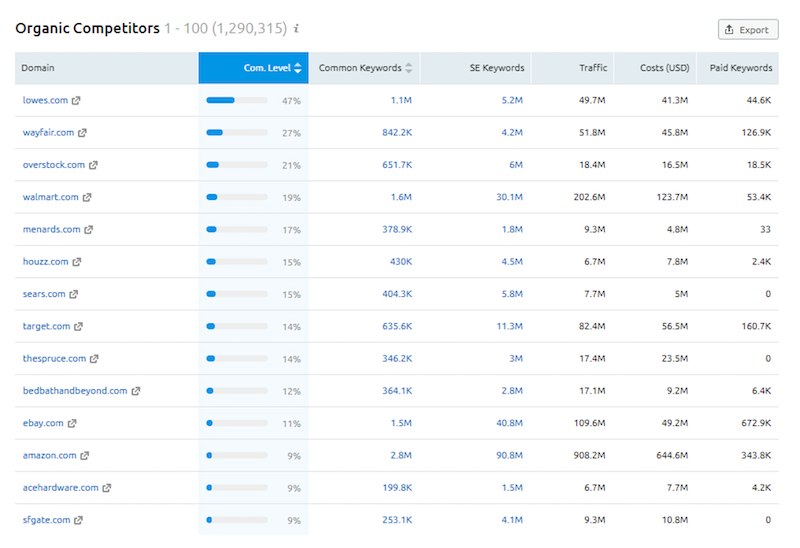
(Source: SEMrush organic competitive research)
Things to Keep in Mind
When you look through the competitors above, you can see large competitors that compete for some of Home Depot’s business, like Bed Bath & Beyond, Costco, and Best Buy. They don’t overlap completely, but they matter for certain parts of the business.
Accordingly, when doing competitive analysis for your site, consider competitors not just for your entire business model, but those competing for a certain segment of the overall market as well.
Who to Compete With and Who Not To
It’s important to note that some sites are not as important for you to outrank than others.
Some websites may rank above you for certain keywords but are not true competitors.
Oftentimes, it is not worth the time commitment to raise your rankings for particular keywords when you’re being outranked by Wikipedia, Facebook, Yelp, Pinterest, among others. These are larger general resource sites that should ideally not be your direct competition.
Instead, it’s best to identify realistic openings. Which keywords are you being outranked for that result in lost traffic for your site?
“White Space”: Finding Keyword Gaps
You have keywords that you already rank well for.
Then you have those where you are lagging behind your competitors.
Sometimes you can realistically improve those rankings and sometimes you might not be able to, or the marginal time and monetary commitment might not pay for itself.
But if you are only a position or a few behind a competitor for an important keyword, and can improve on their content in terms of depth or user experience, it may be worth your resources.
If you are the Home Depot, you might spot certain keywords and phrases where you only a spot or two behind important competition (see image below) that both have reasonably high demand (i.e., search volume).
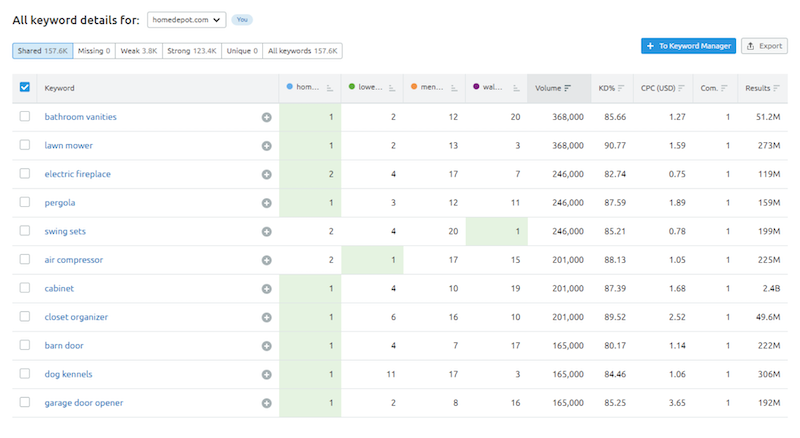
(Source: SEMrush keyword research)
In these cases, leapfrogging just one spot can make a material difference.
Ranking comparisons for your competition
It’s important to pay attention to keywords that all of your competitors are ranking for, but you are not.
This also goes beyond just your main competitor.
For instance, while Home Depot has plenty of traction on the search terms like its top competitors, it isn’t just directly competing with Lowe’s, Wayfair, and similar home improvement and home decor sites.
Sometimes it’s Walmart or companies selling similar products.
For something like “appliances stores,” none of Home Depot’s top competitors may be ranking at the top, but instead the top ranking may be taken by websites like Yelp, Consumer Reports, and/or appliance-focused niche sites.
In short, you should keep tabs on the keywords that your competitors are ranking for, but you are not and see if you can realistically compete for them or improve on existing content.
Why are they ranking well and not you?
Hash out the reasons you may not be ranking as high.
Do they have a higher number of backlinks to those posts and pages that enables them to rank higher?
Do they have better supporting content for those keywords?
When you can identify the reasons and any keyword gaps keeping you trailing your competitors, you can find ways to close that gap.
That can mean pages targeting those specific keywords.
Sometimes it can be an easy fix where you simply create content or make changes to existing content.
If you are simply filling a gap where your site didn’t have content before and your site is already authoritative enough to rank well for it, then that’s usually all that it might take to get your rankings in a competitive position for the term.
Finding Popular Pages
Similar to finding what keywords and key phrases your competitors rank highest for, it is also necessary to see which pages are their most popular.
Important matter to take into consideration:
- Which pages are receiving the most traffic?
- Check why they are the most popular: Are the most trafficked pages receiving visitors because of organic traffic or because of social, one-time bump (e.g., referral), or paid advertising?
- Which pages have the highest percentage of the total traffic on the site?
- Which ones are ranking for the most keywords?
Oftentimes, your competitors can have ample amounts of traffic to a specific page or set of pages. It’s not uncommon for some websites, even large content sites with 100+ pages, to have only a few pages that are giving them the bulk of their traffic.
For the Home Depot, the third-most popular page on their site is related to wallpaper rather than the standard information about construction or building materials.
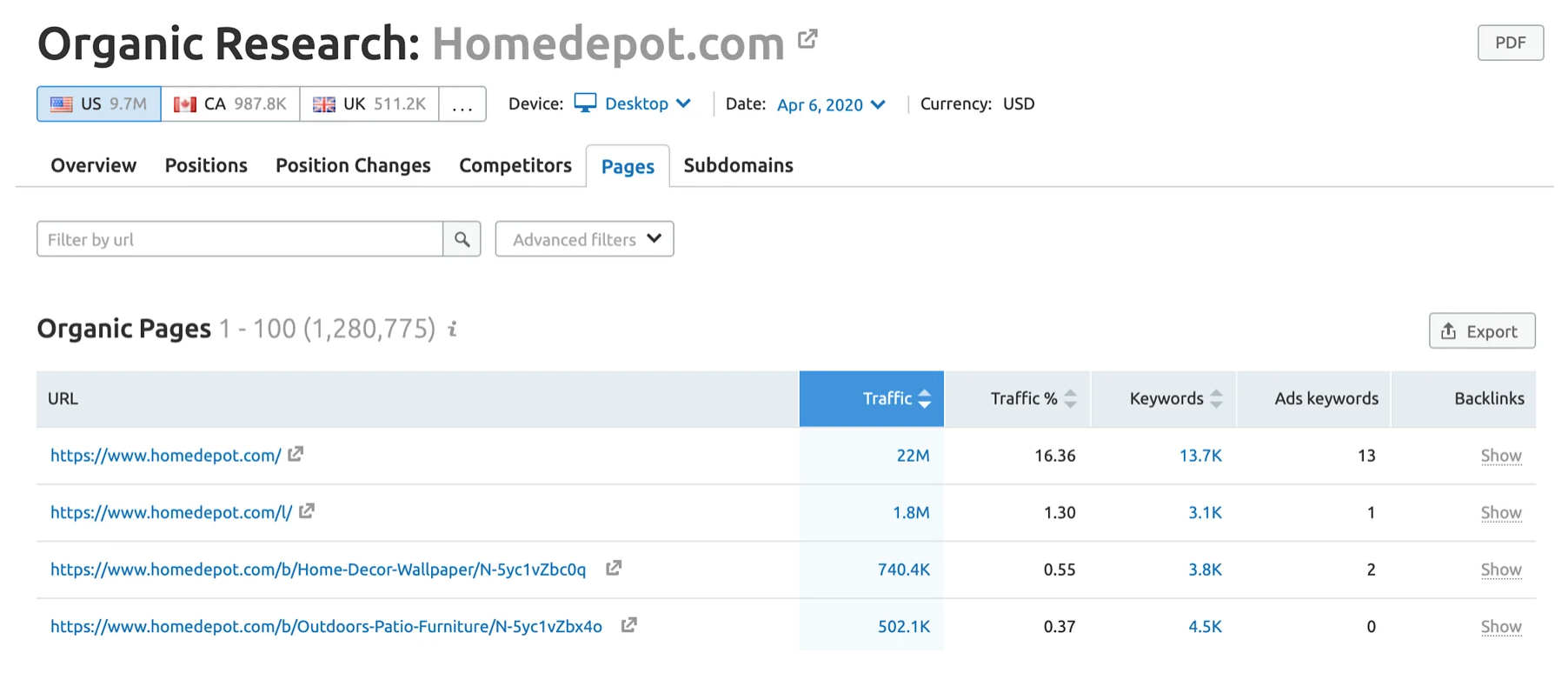
(Source: SEMrush keyword research)
While you might have an idea of what the most popular pages are on competitor sites, this should always be part of your SEO competitive analysis to make sure. You can go through the Organic Research portion of SEMrush to find this information in a straightforward way.
Sometimes it comes with surprises.
Identifying Your and Your Competitors’ Strengths and Weaknesses
Each competitor, like your own site, will have strengths and weaknesses.
What do they do well where you are weak or could better optimize?
It’s important to identify why your site may be weak and not getting the rankings you think you should be getting from Google.
Even massive sites like eBay, Etsy, and Amazon have multiple weak points where they can improve.
If you have trouble spotting weak points with your site, ask your business partners, employees, or a trusted set of eyes what they see. Gather all feedback for improvement.
It’s especially helpful if you are a website that deals with customer support and you (or members of your team) have heard common complaints. Having a consumer survey on your site may also help.
Consider your strengths as well
Also consider the strong areas of your site and see if these strengths are present in your competitors sites as well, but just a bit better.
Focusing on what you’re good at — whether that be engaging content, video, getting quality backlinks, and so on — is great as well. Your competitors can provide insight on how to bring up those strengths as well by mirroring parts of what they do.
Matters of authority
- How authoritative is your site compared to other sites? You can find this ranking using tools like SEMrush, Ubersuggest, and Moz.
- How many important links do they have coming into the site?
If your competitor is a higher authority site, it will be difficult beating them out for competitive keywords, all else equal.
This is why it is important to look at keyword gaps — where are they not competing where you can?
Some keywords have less popularity but still a solid amount of search volume. This can also mean long-tail key phrases that they may not be targeting.
As the authority of your site builds over time, you can target an increasing number of these popular and competitive keywords.
Comparing content
You will need to look at matters relating to:
- The quality of their content. Is it informative and helpful? Is it spaced out and easy to read?
- How thorough is their content? Can it be improved upon to give yourself a better shot to rank?
- Do they focus more on product pages and reviews and not enough on supporting pages and content?
Where they are lacking are places where you can potentially compete.
eCommerce
If you are an ecommerce brand, check out the product pages of your competitors that are ranking well and find out how they’re doing it.
- Do they have supporting content that provides help guides and/or how to tutorials for the product?
- Do they suggest relevant products that are often bundled or bought alongside them?
- How are their ratings and rankings for the product displayed, if applicable?
- How easy is buying their product versus your own (e.g., simplified checkout, no login, one-click purchase)?
Identify a list of things they are doing better and add to the agenda of items you’re looking to change on your site.
Site technical issues
Are any technical issues holding your site back?
If they are technical SEO problems or coding problems that are making it harder for search engines to crawl pages can add easy improvements.
Page speed is important to check as well for both mobile and desktop.
Once sites begin to carry more pages or have more code and scripts added to them, the slower the site can get. Page speed is a direct ranking factor, so it’s important to clean up any issues in that department.
Mobile
While it’s easier to do SEO competitive analysis from a desktop computer, you should also check how their site lays out on a mobile phone as well.
Sometimes your competitors don’t pay much attention to the mobile version of their site even if it receives the bulk of the traffic.
Once technical matters are ironed out, it’s easier to focus on the standard site improvement tasks, such as improving content.
Internal linking infrastructure
Internal linking helps to not only provide helpful links to supporting pages, but also helps search engines with indexing, crawling, and ranking pages.
“Orphan” pages on a site can be hard for Google to find and might not perform as well as those that link out to other pages.
Keeping a clean site architecture is essential to doing well with SEO.
If your site or a competitor’s site lacks a solid internal linking infrastructure, it’s one thing to take advantage of.
Take a look at how competitors have structured their sites. Look at the URL, the permalinks (what follows after the domain name — e.g., /seo-competitive-analysis is the permalink for this article), anchor texts, and breadcrumbs.
If an entire section of a site is only sparsely linked internally, you can look through your content log and find pages and posts to link to whenever you have relevant keywords.
Sometimes ranking losses can be attributed to faulty technicals or poor linking that makes the site less friendly to web crawlers, and not always due to “competition” or an algorithm change by Google or other search engines.
Lost and Declined Keyword Rankings
What keywords have your competitors recently lost or have never targeted or rank for?
Focusing on those with the largest search volume and/or the largest potential commercial interest — i.e., search volume multiplied by CPC — is a good prioritization tactic.
Pages that formerly rank but no longer do could be for many reasons, such as technical issues to competition to spam to simply taking it down, and so on.
Lost Rankings for Competitors
When a competitor is slipping in the rankings or losing them altogether for certain keywords, you can take advantage.
You can find these in the SEMrush Organic Research tool.
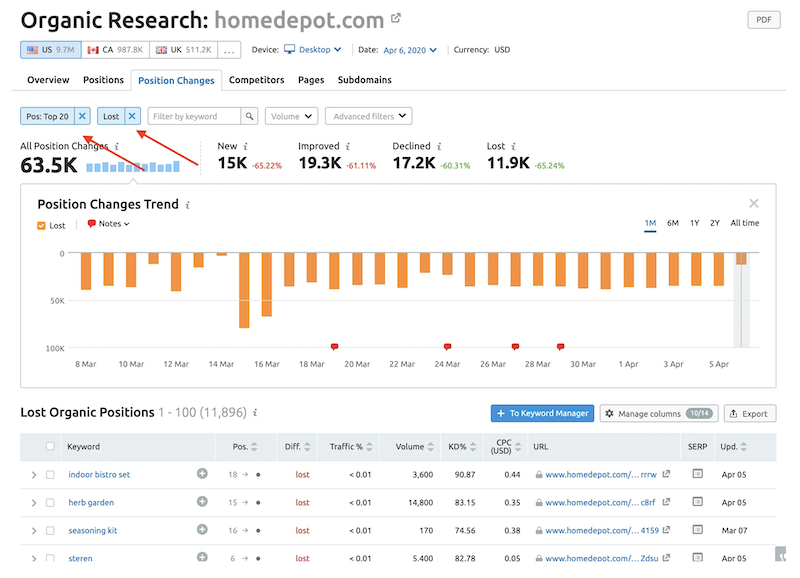
Take a look where their search rankings are declining.
Particularly when the competitor doesn’t notice where these losses are occurring and not taking actions with their content, site, or otherwise to fix what is causing these rankings to drop in the first place, this presents opportunities for you.
New Keyword and Key Phrase Rankings
Keyword rankings is a fairly standard part of competitive analysis and SEO research, and should be completed on a fairly regular schedule.
Any new pages or new rankings that your competitors are getting is something you’d like to keep tabs on, to see what’s how and anything new they might be focusing on.
If you’re an ecommerce company, it might be relevant to any insights on new products or product types that you could also capitalize on. Generally, companies make decisions because it helps make them revenue.
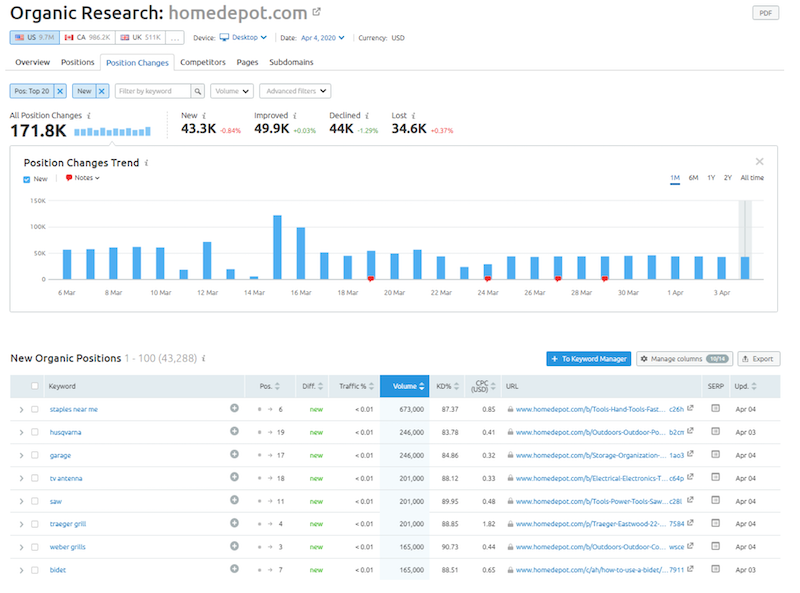
SEO competitive analysis for new keyword rankings
Consider a keyword like “proptech,” which has undergone a surge in popularity.
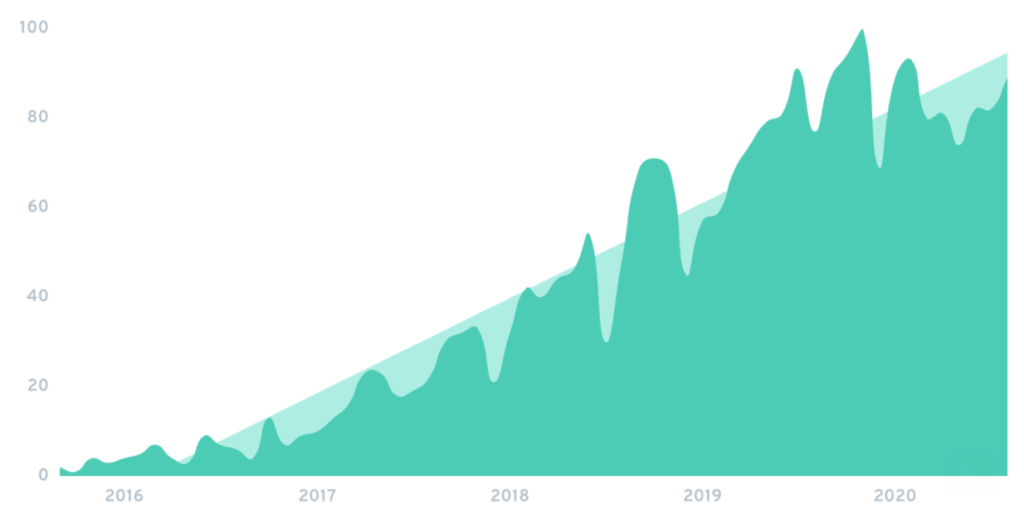
PropTech (short for “Property Technology”) applies to any product that incorporates technology into real estate development, management or transactions.
You will find that not many sites rank with respect to proptech given its relative newness as a keyword, which can give you opportunities if it’s a niche or product that you could provide to your audience.
What type of page is ranking?
Is it a product page or is it a piece of supporting content (e.g., how to guide, informational)?
Different types of pages rank for different keywords.
Regular word-based content will also compete with video, especially YouTube videos given it’s a Google-owned property.
Analyzing Page by Page
Once you’ve looked at the search results of particular keywords and key phrases, then you need to go on a page by page basis comparing your pages to those of competitors outranking you.
Comparing pages directly will help you find specific issues or potential areas of improvement for each page in which your competitors are ranking above you.
Titles
Title is a material factor in SEO, as it labels what the page is all about.
Sometimes Google will change the title of a page depending on the type of search, so if doing SEO competitive analysis be sure to look at the title directly from the page of your competitor.
Meta Description Tag
Many webmasters choose to write in their own meta description tag such that it contains their target keyword or key phrases. And sometimes it is well-written and engaging. If it improves the click-through rate of a page, that matters for ranking purposes of a page.
Google may overwrite the meta description tag, but it may be worth noting what your competitors are doing with their meta tags versus those used on your own site.
Meta Keywords Tag
The meta keyword tag can be useful when someone is putting in the keyword tag for non-Google-related SEO purposes.
H1 Tags and Other Headings and Sub-Headings
Google does pay attention to tags as ranking signals. Using keywords in the tags does help for SEO purposes (though to a lesser extent than in the title).
Google may also use these headings in featured snippets and various other search features. So be sure to check out what your competitors are doing with their tags and what impact it’s having on their organic search performance.
Breadcrumbs and URL Structure
Your URL structure and using breadcrumbs can help Google understand the structure and hierarchy of a site and help it decide how to rank it.
Content and Keywords
Things to keep in mind with respect to keyword within the context of content:
- How are your competitors using keywords within their content?
- Are they using similar keywords you should also be adding within your content? (Studying up on top results can be helpful, especially if niche sites are doing particularly well for competitive terms.)
- How is the quality of the content itself (thorough, helpful)?
- How does your competitors’ word count compare to your own? While word count is not a direct ranking factor, longer posts tend to rank higher being more in-depth. They are more likely to answer the searcher’s query.
- How does your readability stack up relative to the competition? Shorter words and spaced out content in a more conversational style does better than more traditional, academic styles of writing.
These are all matters to consider when choosing keywords and creating content.
The SEO Content Template from SEMrush can help you with its recommendations. It will provide links to rivals, similar keywords to integrate, readability info, and more helpful information to identify keywords as they relate to content.

See how your competitors use your target keyword.

Backlinks: What to Look For
Analyzing backlinks is an important part of SEO competitive analysis.
When a competitor has a significantly better backlink profile, particularly high-quality backlinks from reputable websites, it will mean you will have a harder time competing against them until you can build up a similar backlink profile.
Backlinks serve like a voting machine, helping inform Google what sites are more reputable and trustworthy than others.
It is also important to discern between high-quality links and low-quality links.
Google changed how they handle low-quality backlinks with the Penguin update.
If you see a competitor with a high amount of low-quality links, those links may not be helping them much at all given the authority and trustworthiness of those sites is lower.
Accordingly, they won’t pass on much “juice.”
If you follow their link-building and go for quantity over quality with your backlinks, this could actually harm your own organic search rankings.
Because you are not able to view what your competitor is disavowing link-wise, be wary of wanting to simply copy what competitors are doing when it comes their link profile. This is especially true if the sites linking to them are not good to excellent in terms of reputation.
High-Quality Backlinks
You want to focus on high-quality backlinks.
These include those from important news sites, high profile sites or experts in your niche.
When looking at your competition’s backlinks, consider these questions:
- Have they received positive press among major news organizations? If so, can you can get yourself into similar stories?
- Are they a recommended source on high-authority but non-commercial sites within your niche or industry?
- How can you get yourself in the top resources that people look to for information?
Nofollow vs. Followed Backlinks — A diverse assortment is a plus
You want to check for nofollow versus followed links.
Google doesn’t use nofollow links for their algorithms on their own, so they won’t necessarily pass on link juice from an SEO standpoint.
However, they can be an important source of referral traffic that can build upon your brand awareness, increase traffic, and result in conversions.
So, be sure not to ignore high-quality links just because they are nofollow. While the SEO value may not be there per se, there can be a lot of non-SEO value in all of those links, particularly if coming from a large site.
Analyzing backlinks is a critical part of competitive analysis.
When a competitor has a significantly better backlink profile, especially high-quality backlinks from reputable websites, it will mean you will have a harder time competing against them until you can build up at least a similar backlink profile.
Within the dofollow category, is also important to distinguish between high-quality backlinks versus low-quality backlinks.
Because of the way Google changed how they handle low-quality links with the Penguin update, if you see a competitor has a high number of low-quality links, those links may not be helping them anyway.
If you follow in their footsteps and go for quantity over quality with links, you could actually harm your own SEO. Because you can’t see what your competitor’s disavowal file is, be wary of wanting to copy competitors directly when it comes to lower quality or even spammy links.
Links from Reputable Sites
If your competitors are getting backlinks to similar pages that you have, that provides an opportunity to contact the webmasters of those linkers for backlinks of your own.
SEMrush has its own feature called the ‘Backlink Gap‘ to check for links that may be easy to score and help your rankings.

If they are frequently linking to your competitors, then it increases your odds that you’ll be able to get links as well.
Links also go beyond the homepage. Links to internal pages are important too and are important to check over the course of an SEO competitive analysis.
Internal pages could have links that are a major factor behind why those pages are ranking well.
Types of Content and How to Analyze Them in SEO Competitive Analysis
How does your content mix stack up in comparison to your competition?
Content sites and ecommerce sites have different focuses.
Ecommerce sites are primarily about their product pages and are the most relevant pages to compare.
Supporting content for ecommerce sites are also important to compare and can be a useful way for these sites to pick up an SEO leg to their marketing and pick up backlinks. (Ecommerce typically runs through paid ads and/or social media and don’t focus on SEO to the same extent as content businesses.)
Content sites focus more heavily on blog posts and articles.
Check out all content your competitors push on their sites, including blog articles, how to tutorials, video, infographics, news content, opinion pieces, and so on. Practically anything that ranks well in the SERPs.
Identify areas where you lack compared to your competition.
- Do they have a blog that tends to get a lot of social shares and backlinks?
- Are they making and promoting videos either on a standalone basis or as part of their regular blog articles?
- Infographics?
- Podcasts and live streams?
When you identify competitors that are doing better for certain types of content, you can then explore whether you should add these content types as well, while also making sure that they add value to your site.
Some people would rather consume video than a blog article and vice versa.
But video is also a different type of commitment. Not everyone wants their face on camera and the editing and overall production process tends to be more involved than with a standard text article. It could also be hired out. The owner(s) or founder(s) don’t have to be “the face” of the business.
Not every industry is best suited to video marketing.
Podcasts are also the same. Many people in certain audiences love podcasts, while others are not very receptive to them.
Identifying Search Features
Different types of content are treated differently in search features.
If Google is displaying these types of content in the search results for your top keywords, then it becomes more important to have this type of content in your repertoire, or at least the ability to create it.
For example, reviews on certain types of electronics like mobile phones may have more video content than most other types of queries.
This can help you to obtain as much of the space on the search engine results pages as possible.
Search Feature Types
Not all rankings are created equal.
Some results pages are heavy with ads taking up a lot of digital real estate. Some have maps and local search features. Some have search features and featured snippets, and so on.
SERP feature data for HomeDepot.com from the SEMrush Organic Research tool

Ranking third in the SERPs might be great for some searches, but if this comes after text ads or product listing ads, videos, images, maps, search features, people also ask, etc., then it’s going to much more difficult to derive traffic from that ranking than a standard #3 ranking without all the various types of content above you.
A lot of those results are designed to save people a click in the first place so they stay on Google.
As a general trend, Google wants to help users answer their questions as soon as possible. If it helps the user save a click, that’s what they’ll try to do.
For example, if you want to do an exchange rate conversion for a certain amount of money, you will probably be able to that with an exchange rate calculator at the top.
The same is true if you want to check the local weather or found out what time it is in a different part of the world. You will probably be able to run the search without needing to click through to a certain website.
Featured snippets and people also ask serve the same purpose.
All of this information being displayed within the SERPs itself obviates the need for the user to click through a lot of the time.
It may take investing in new types of content (video, calculators, tools, data feeds, etc.) to get a superior ranking.
This is especially true as search engines evolve over time.
Google has transformed from basic ads and organic results to a more eclectic compilation of content designed to answer the user’s query.
One should expect this to continue over time.
Ranking Opportunities
You may need to go beyond standard word posts and into video and other types of content to take over more SERP real estate.
See what features are listed for your top keywords and how to build content to fit what the SERPs display.
This could mean more FAQ-style headers to fit the people also ask section, for example. Or video, which is often prioritized at the top of the SERPs should it make the cut in terms of answering the user’s query.
For instance, you can observe in this search result that the top two results in “best desktop computer for working from home” you have a featured snippet, followed by a people also ask section before you get to the organic results.
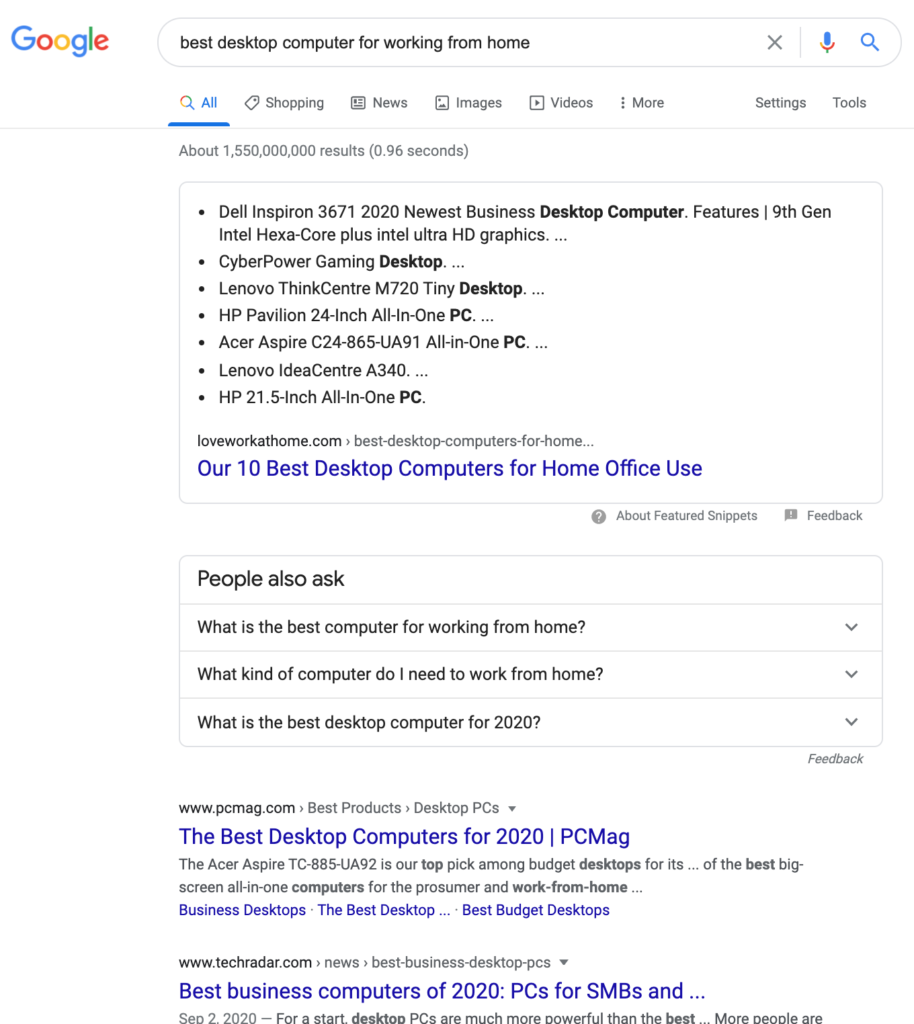
The people also ask section begins expanding should people search within it to display the answer and also by the number of questions. This takes up even more real estate that could prevent users from clicking on an organic search.
In this case, if you were competing for this keyword, you’d want to organize your content to make it easily parsable to give yourself a better chance at making a featured snippet.
Headers that better fit “people also ask” (by making the words in your content as close to the ones featured) can also get you featured there.
For these types of search results with multiple search features, there is a greater importance on getting that first position ranking.
The position of the people also ask changes depending on the query and is dynamic on its own — and not all searches display featured snippets, videos, product listing ads, etc. — but these features may prevent results beyond a certain position from even being seen above the fold on desktop.
What Search Features to Target
If you were to decide that the most important search feature for your site is featured snippets, then you would want to look at each of your competitors and identify what featured snippets they are ranking for.
Then, check out the page the snippet links to and see if you have a similar page that you feel would be a good fit for taking over the featured snippet by molding the content to best fit what it’s prioritizing within the snippet.
How can each page be altered so Google may select it as a featured snippet?
Here is SEMrush data regarding Home Depot’s positioning for featured snippets based on keyword volume.
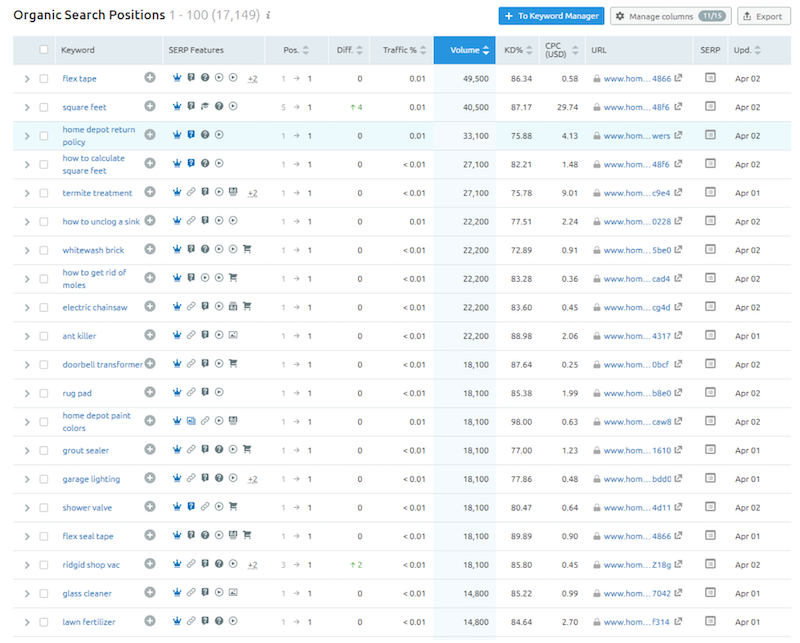
(Source: SEMrush Organic Research tool)
Checking out the above list, a few things come to attention.
Home Depot has a lot of featured snippets, which is natural considering their brand authority.
But they are not getting much traction on the a lot of the other search features aside from a decent amount of “people also ask” features.
Accordingly, if you were a Home Depot competitor, you might look at getting some of those search features that Home Depot is lacking, while also trying to outrank them in keywords they might lack.
If you compare Home Depot to its competitor Lowe’s, the latter has quite a bit fewer featured snippets rankings.
But they appear in many more video carousels relative to Home Depot.
This means each of your competitors may do a bit better on a different part of the Google SERPS, which is important to note in a thorough SEO analysis.
This could reflect marketing priorities or gaps in the skills of those operating the site.
Providing Solutions to Your Audience Beyond Merely Commercial Terms
When you are doing SEO competitive research, you do not want to only check out the commercial or product keywords that focus on sales.
For instance, Home Depot has several “how to” keywords that rank with a significant search volume, including those in featured snippets that will entice quality click-through.
These, in turn, lead to help pages that link to products used in the step-by-step written tutorial or video. This generates revenue.
Moreover, these pages will generate backlinks to help generate higher rankings for your other content. Not all pages need to be directly commercial.
Google also doesn’t like thin affiliate sites. They prefer sites that help their audience first and foremost. That can include a product, but most searches are people not looking to buy anything.
It’s also worth noting that not all search features are available in all countries. Whatever search features you are targeting, make sure that they exist in countries with a large fraction of your targeted audience.
Schema Markup Tips
Some search features are taken directly from content on the page, while other search features use schema.
For schema-based search features, it often is a good choice to add the appropriate schema to a page if you are updating it, even if Google doesn’t use it as an active search feature in their search results.
It could change in the future if Google turns on a search features that uses that specific schema and you will be ahead of your competitors.
Moreover, you want to check out your competitors to see what they are doing with their schema markup before Google officially integrates it into their search algorithm.
A lot of SEO competitive analysis is not only observation of the current landscape but also in thinking where Google is likely to go.
Keep in mind that they’re always looking for ways to improve the way users can get their information in the best format possible.
Featured Snippets & How to Analyze Them
Featured snippets can sometimes be easier to get from a competitor in comparison to top rankings.
Google will use featured snippets when they are accurate, concise, and provide the user with the type of information they’re looking for.
Accordingly, as you look through your competitor’s featured snippets, consider how you can readjust your content for pages that are ranking in the same search engine results page. This will give you a chance to take over the featured snippet.
Using Home Depot as the running example, you can see that they’ve been increasing their number of featured snippets each month.
This means they might simply be producing more content or Google is rolling out the feature more broadly.
But it could also mean they’re actively optimizing for it since it’s generally an easier way of getting featured at the top of the SERPs relative to trying to get the top ranking.
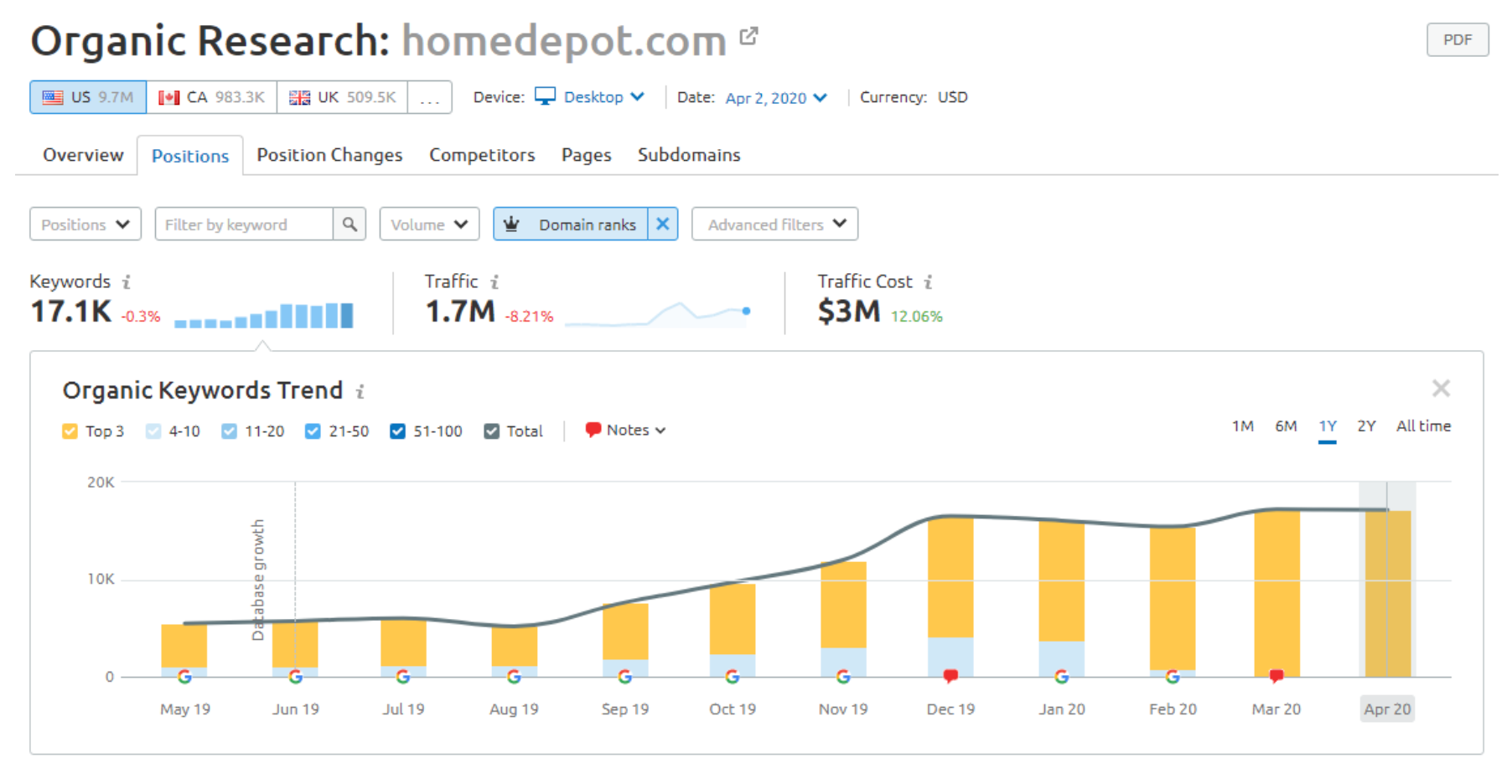
When looking at their competitor Lowe’s, it shows they’ve been losing many of their featured snippets, so it is likely their marketing department doesn’t place much emphasis on them and they may be easier to take over from them in the SERPs.
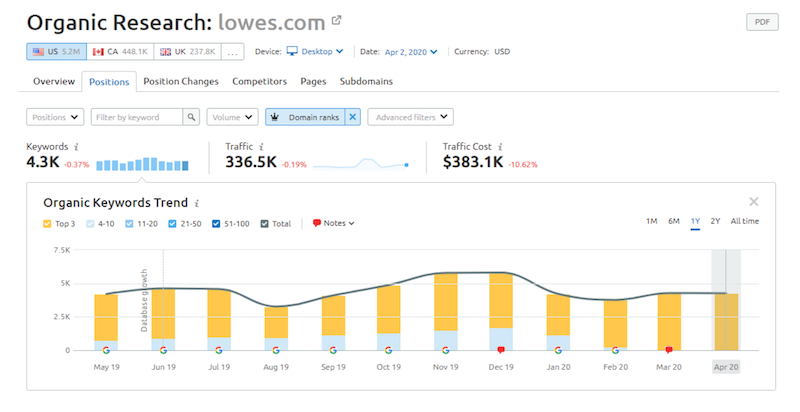
Doing SEO Competitive Analysis after Major Algorithm Updates
Google makes several algorithm changes on a regular basis (hundreds per year), but every year or so a major update is released.
Whenever this occurs, it is important that you go through your SEO competitive analysis tasks and reevaluate your most important rankings and keywords/key phrases.
- How did your rankings move overall and page by page?
- Did one of your competitors come way up and now ranking at the top or near the top for many of your most important keywords
- Did another competitor fall a lot, and is that something you can exploit?
SEO competitive analysis is an ongoing, continuing process. It is never something to be done once and never repeated.
When doing an in-depth analysis, it’s important to take the time to analyze each aspect of all sites in your niche.
Internet marketing is one of the fastest changing industries.
As things change with algorithm updates, site migrations, new search features being released, and new content and pages being released daily, it’s essential to reevaluate and see what’s changed since the last analysis.
Often it’s not even that your competitors have changed their approach to make them rank higher when an algorithm update is rolled out. It could have been the tactics that they were pursuing all along, but Google slightly tweaked something to reward that.
For example, many SEO marketers approach their sites “conservatively” with the expectation that playing the long game with aboveboard tactics will win out in the end.
This could mean not being overly intrusive with pop-ups, creating entirely unique and thorough content, no private blog network (PBN) links, no buying links, or other black or gray hat SEO tactics. Or anything involving “gaming the system” in some form that, even if it works now, will probably be punished down the line.
Some marketers are conservative to the point where they rely 100% on organically obtained, editorially placed backlinks.
While most SEO entrepreneurs are more active with link building campaigns, the “passive” link building approach that entirely reflects backlinks achieved in a totally natural way is ultimately what Google wants to reward and is likely to reward to the best scope of their abilities.
With SEO competitive analysis, identifying what your competitors are doing better and adapting as much as you realistically can within the scope of your team’s skills and resources is a quality approach to “weather” or improve your competitive positioning whenever the next major update rolls out.
Conclusion
Ideally, you will want to rerun an SEO competitive analysis every quarter to six months.
Parts of it you should perform each month to ensure you’re staying on track. Ensure you have an eye on changes competitors are making so you can make any appropriate tactical adjustments.
Whether it’s watching for new pages, new keywords or key phrases, new types of content, ranking adjustments, or an increase in search features such as featured snippets, SEO competitive analysis is an ongoing process for improvement.
As sites and search results evolve, keeping tabs on your competitors with competitive analysis means you will know what they are doing better and ideally stay one step ahead of them.
Appendix
Throughout this article, we used SEMrush as our competitive intelligence tool.
 |
SEMrush |
||||||
SEMrush offers solutions for SEO, app store optimization (ASO), pay-per-click (PPC), content ideas, social media, marketing automation tasks, and competitor research.
The SEMrush platform is perhaps best known for shedding value-additive insights on your competitors’ SEO tactics.
With SEMrush, marketers can find insights on:
- domain analytics
- keyword analytics
- topic research
- gap analysis
- SEO position tracking
- content templates
- writing assistants
- lead generation
- CPC map
- Traffic Jet (ad automation solution)
- marketing calendar
- project dashboards
- custom reports, and more
SEMrush is trusted by over 6 million marketers worldwide and offers a Free Trial.